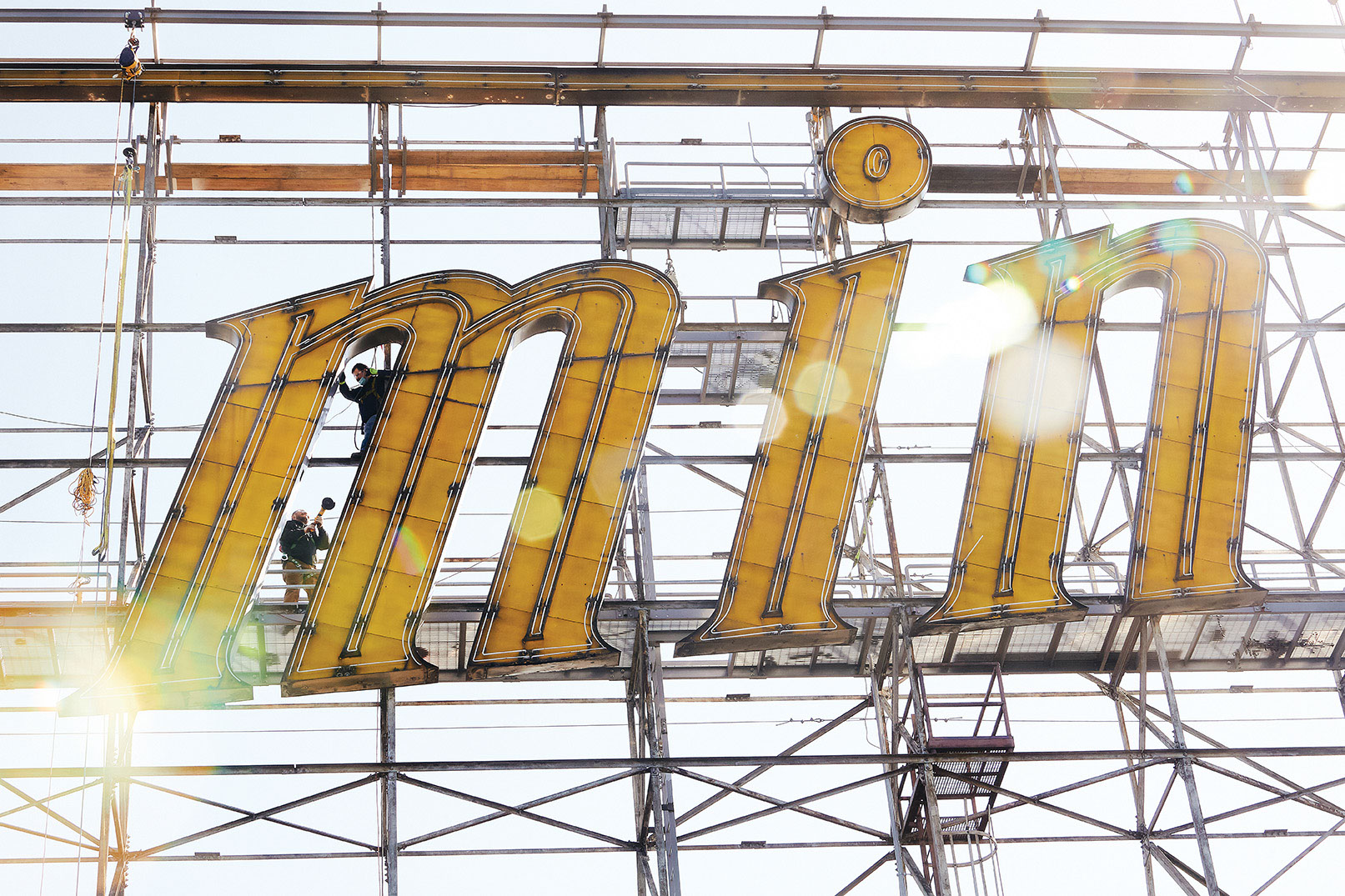News & Community
When the Domino Sugars Sign First Went Up in 1951, There Was No Fanfare
Now, Baltimore awaits the official unveiling of a new LED sign slated for July 4.

Whenever Paul Gable looked up at the 120-by-70-foot, neon Domino Sugars sign lighting up the Inner Harbor skyline, he marveled at its unique lettering. “I’m a type-setting geek,” says Gable.
So it came as an honor, and a bit of pressure for the perfectionist, when his Baltimore design and manufacturing company was hired to replace the weather-beaten, 70-year-old landmark, which came down amid an outpouring of affection and nostalgia in March.
Noting the famous beacon was fabricated by Artkraft Strauss Co., which made many of the classic signs in New York’s Times Square, Gable says he occasionally pictured the original designer putting pencil to grid paper and hand-drawing the one-of-a-kind font.
“The lower case ‘g,’ which is 24-feet tall, by itself is a work of art, keeping in mind there was no technology for reproducing an image to scale in those days. It was laid out by hand.”
The Gable Company, started 40 years ago by Gable in his parents’ Anne Arundel backyard, is tasked with essentially digitally re-mastering the 4,440-feet of neon tubing with state-of-the-art LED lighting that will mimic the old sign’s Halloween-orange appearance. It will also be more sustainable, in terms of energy usage, and durable, in terms of surviving high winds and storms.
“Trust me, when a letter goes out, we hear about it,” says Peter O’Malley, vice president of corporate relations for Domino’s parent company, American Sugar Refining, as he gives a tour of the bustling, 30-acre, 14-building plant.
The official unveiling of the new sign is scheduled for July 4.
When the Domino Sugars sign was first illuminated on April 25, 1951, it wasn’t to any great fanfare. The Inner Harbor in those days was very much a working port, filled with longshoremen lugging cargo hooks and banana boats puttering around the Pratt Street docks.
In the ensuing decades, however, the hulking sign became a symbol of the city’s industrial heritage, and Baltimoreans were not happy when the sign was briefly unplugged during the 1970s energy crisis. Long gone now are Domino’s contemporaries and former Inner Harbor icons like McCormick & Company, Coca-Cola, and Allied Chemical. They’ve been replaced, to the extent that they can, with the corporate offices of Legg Mason, Morgan Stanley, Exelon, and Under Armour, which sits on the Tide Point site of the old Proctor & Gamble complex.
Meanwhile, the 1922-built Domino factory keeps rolling, with sugar tankers arriving almost weekly from Florida, the Dominican Republic, Brazil, Colombia, and Africa.
“This facility processes more than 98 million pounds of sugar a year,” says O’Malley. “Why are we still here? It comes down to demand, which is increasing as the country keeps growing, and it comes down to location. It’s the deep water. We can get these ocean-going vessels in here from all over the world. We also have the interstate highway system nearby, we mostly lean on trucks for distribution, but we’re served by rail here, too.”
Stepping off the elevator and climbing to the top of the nine-story main building, O’Malley gestures toward several of the massive, recently disassembled letters lying on the roof. The dot in the “i,” which is tall enough for the 6-foot O’Malley to stand in when upright—is headed to the nearby Baltimore Museum of Industry. Others are on their way to Second Chance, the nonprofit reclaim store and job training center.
Outside the energy crisis and rust, the last major threat to the Domino sign was an explosion and major fire in 2007. Some 175 employees evacuated as 100 firefighters fought the blaze, which made national television news. The explosion shook nearby buildings, and it was a miracle that no one was killed, says Stuart FitzGibbon, who was plant manager at the time.
That evening, with most of the facility’s power knocked out, FitzGibbon’s team told him that he had one of three options: He could turn on the refinery, he could turn on the packaging department, or he could turn on the sign.
“And they were in a state of shock when I told them to turn on the sign, because our job was making product,” the since-retired FitzGibbons says. “‘We need to let the city know we’re still running and we need to let our employees know we’re not going anywhere and we’ll get through it,’ I said. There were a lot of rumors flying around that people had been killed and the plant wouldn’t be able to re-open. It was an emotional moment. We put the sign on, and it was all over the 11 o’clock news.”
[Editor’s Note: After this piece was reported and published in our May issue, the Domino factory experienced another fire that broke out in the refinery’s raw sugar shed on April 20. Thankfully, no injuries occurred, and the plant has since resumed full operations.]